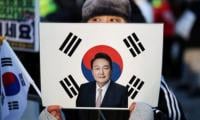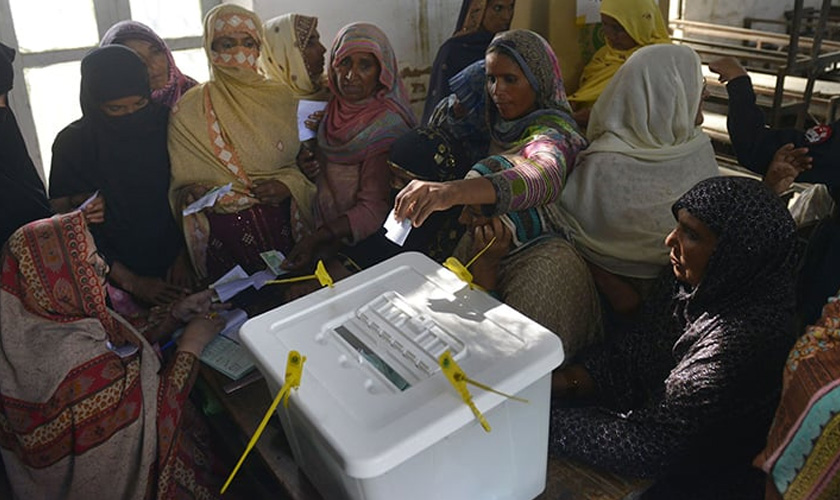Voter turnout: Pakistan trails behind India, Nepal and Sri Lanka
LAHORE: Pakistan, with 86.9 million registered voters, which had recorded a 55.02 per cent voter turnout in the May 2013 elections, is currently trailing behind India, Nepal and Sri Lanka, where a lot more voters had come out of their homes to cast their ballots in polling exercises held between 2014 and 2017.
However, Pakistan is far ahead of Bangladesh where voter turnout was only 22 per cent in the 2014 elections, marred by violence and boycott by the main opposition party, the Bangladesh Nationalist Party led by three-time former prime minister Khaleda Zia.
Results of 139 seats out of 147 were released with Sheikh Hasina Wajid's Awami League winning 105, former president Gen Hussain Muhammad Ershad's Jatiya Party winning 13, the Workers Party winning four only.
During the 2014 Indian general elections, the world's largest democracy had registered a voter turnout of 66.38 per cent, as 551 million voters came out of their homes to cast their ballots.
According to the Election Commission of India, the country had set a record for huge voter turnout. Over 814.5 million people were eligible to vote during the country's 2014 ballot exercise, with an increase of 100 million voters since the last general election in 2009, making this the largest-ever election in the world. Around 23.1 million or 2.7 per cent of the total eligible voters were aged 18–19 years.
In Sri Lanka, the presidential elections were held in January 2015, two years ahead of schedule. A record 81.52 per cent voter turnout was recorded in the polling exercise to elect the President (Maithripala Sirisena) and a 225-member legislature for a five-year term. Some 12,264 million of the registered 15.044 million voters had exercised their right of franchise.
The legislative elections were held in Nepal in two phases on November 26 and December 7, 2017 to elect the 275 members of the lower house of the Federal Parliament of Nepal.
Nepal, having 10.587 million registered voters, had recorded a 68.63 voter turnout.
In May 2013, a document of the National Database and Registration Authority (NADRA) and the Election Commission of Pakistan (ECP) had revealed that Pakistan was ranking among the bottom four countries in terms of voter turnout.
According to the booklet jointly published by NADRA and the ECP, Pakistan had stood at 164th position in terms of voter turnout among the 169 counties, which had held democratic elections over the past 50 years.
According to the ECP, voting in Pakistan has never been a compulsion, a fact that has been a major reason for the low turnout.
The Election Commission of Pakistan had noted in 2013 that Australia was one of the first countries that had adopted compulsory voting system, which led to an enviable better voter involvement ratio, as high as 94.5 per cent.
Research shows that Pakistan, with its average turnout of 45.3 per cent till date, is only better than the countries like Egypt (45.1 per cent) and Ivory Coast (37 per cent).
According to the World Bank’s 2017 World Development Report, election turnout was declining across the world. Over the last 25 years, the World Bank had asserted, average global voter turnout rate had dropped by more than 10 per cent.
The World Bank’s 2017 World Development Report had maintained: "The drop-off in global voter turnout, which began around 1990, coincides with the fall of the Soviet Union and the introduction of many new electoral democracies. But lower voting rates in these nascent democratic countries do not explain the decline of voting rates over the last several decades. An analysis by the Institute for Democracy and Electoral Assistance (IDEA) finds that though voter turnout was initially lowest in post-Communist countries, both established European democracies and post-communist countries have seen significant declines over the last several decades."
The Report had added: "While Compulsory Voting laws are not always strictly enforced, their presence or absence can have dramatic impacts on turnout. In Chile, for example, turnout plunged after the country moved from compulsory to voluntary voting in 2012 and began automatically enrolling eligible citizens. Even though essentially all voting-age citizens were registered for Chile’s 2013 elections, turnout in the presidential race plunged to 42 per cent, versus 87 per cent in 2010 when the compulsory-voting law was still in place."
Research further shows that turnout in more recent global elections has bumped up in several of the 36 member countries of the Organization for Economic Co-operation and Development (OECED).
In Hungary’s parliamentary elections of April 2018, nearly 72 per cent of the voting-age population voted, up from 63.3 per cent in 2014.
In the Netherlands, turnout rose from 71 per cent in 2012 to 77.3 per cent in March 2017. And turnout inched above 69 per cent in September 2017’s German parliamentary election – the highest level since 2005.
However, in May 2018, it was observed that the United States was far behind most developed countries in voter turnout.
The globally-acknowledged Pew Research Center, a nonpartisan American fact tank based in Washington, D.C., had viewed that nearly 56 per cent of the country's voting-age population had cast ballots in the 2016 presidential election, representing a slight uptick compared with 2012 but less than in the record year of 2008.
The US Census Bureau had estimated that there were 245.5 million Americans (ages 18 and older) in November 2016, about 157.6 million of whom had reported being registered to vote.
And just over 137.5 million people told the US Census Bureau that they voted in 2016, somewhat higher than the actual number of votes tallied – nearly 136.8 million, though that figure includes more than 170,000 blank, spoiled or otherwise null ballots.
The highest turnout rates among OECD nations were in Belgium (87.2%), Sweden (82.6%) and Denmark (80.3%). Switzerland consistently has the lowest turnout in the OECD: In 2015, less than 39% of the Swiss voting-age population cast ballots for the federal legislature.
Belgium, of course, is one of the 24 nations around the world with a compulsory voting system.
-
 North West Raps About Piercings, Tattoos And Skipping School In New Song
North West Raps About Piercings, Tattoos And Skipping School In New Song -
 Teddi Mellencamp Shares Hopeful Health Update Amid Cancer Battle: 'Cloud Is Lifting'
Teddi Mellencamp Shares Hopeful Health Update Amid Cancer Battle: 'Cloud Is Lifting' -
 Prince William Makes Clear The Conditions He Has For Meeting Prince Harry
Prince William Makes Clear The Conditions He Has For Meeting Prince Harry -
 Sara Foster Slams Age Gap Relationship After 'blah' George Clooney Date
Sara Foster Slams Age Gap Relationship After 'blah' George Clooney Date -
 Jennifer Garner Recalls Enduring Ben Affleck’s Intense Beyoncé ‘Halo’ Phase
Jennifer Garner Recalls Enduring Ben Affleck’s Intense Beyoncé ‘Halo’ Phase -
 Prince Harry’s Mental Health Ends Up At Stake As Meghan Moves Him To 'second Fiddle'
Prince Harry’s Mental Health Ends Up At Stake As Meghan Moves Him To 'second Fiddle' -
 Bradley Cooper On Who His Mother Thinks Is The World’s Best Actor
Bradley Cooper On Who His Mother Thinks Is The World’s Best Actor -
 Meghan Markle Offers Glimpse Into Intimate Dance Moment With Harry Amid Split Rumors
Meghan Markle Offers Glimpse Into Intimate Dance Moment With Harry Amid Split Rumors -
 Jon Bon Jovi Joins The Viral 2016 Throwback Trend With Nostalgic Photos
Jon Bon Jovi Joins The Viral 2016 Throwback Trend With Nostalgic Photos -
 Kate Middleton Hailed For Her Lack Of ‘obligation’ As Well As Altruistic, Selfless Qualities
Kate Middleton Hailed For Her Lack Of ‘obligation’ As Well As Altruistic, Selfless Qualities -
 Jason Momoa Says Being With Beau Adria Arjona Feels 'perfect'
Jason Momoa Says Being With Beau Adria Arjona Feels 'perfect' -
 Idris Elba Says One Mix-up Nearly Cost Him A Knighthood From King Charles
Idris Elba Says One Mix-up Nearly Cost Him A Knighthood From King Charles -
 Andrew Mountbatten Windsor Incurs Anger Of Biggest Royal
Andrew Mountbatten Windsor Incurs Anger Of Biggest Royal -
 Megan Fox, Machine Gun Kelly's Relationship 'is Just About Co-parenting'
Megan Fox, Machine Gun Kelly's Relationship 'is Just About Co-parenting' -
 Prince Harry, Meghan Markle Warned They Can’t Fool Brits Because It Won’t Land
Prince Harry, Meghan Markle Warned They Can’t Fool Brits Because It Won’t Land -
 South Korea’s Ex-president Yoon Suk Yeol, Sentenced To 5 Years In Prison: Key Details Explained
South Korea’s Ex-president Yoon Suk Yeol, Sentenced To 5 Years In Prison: Key Details Explained




